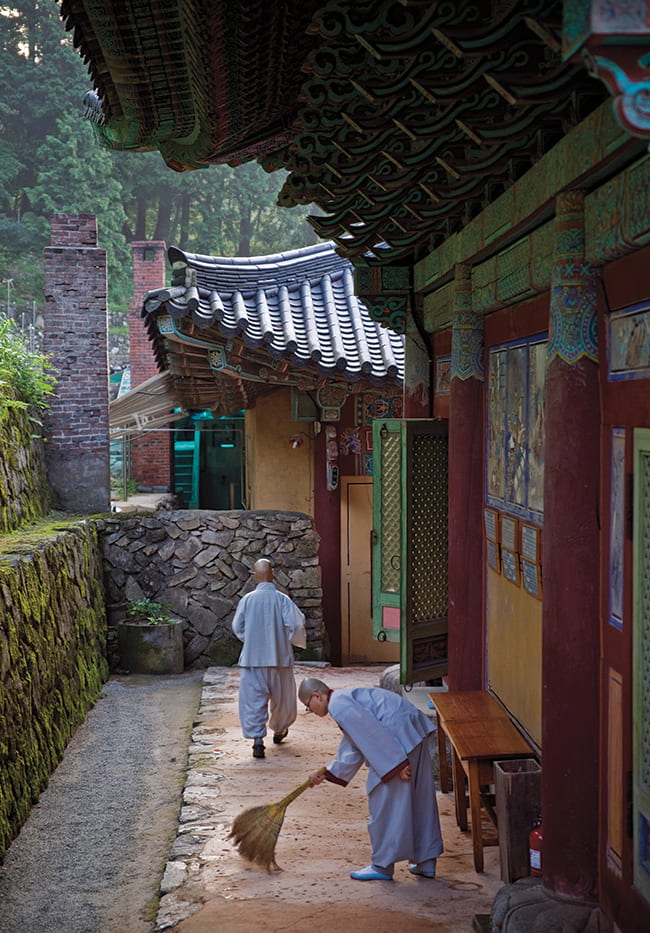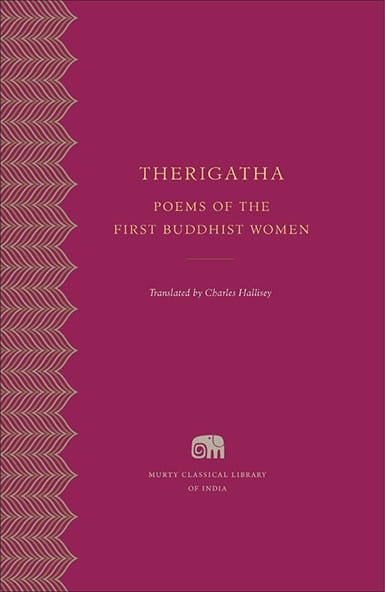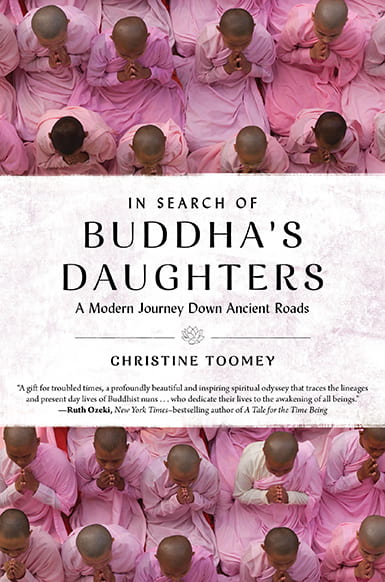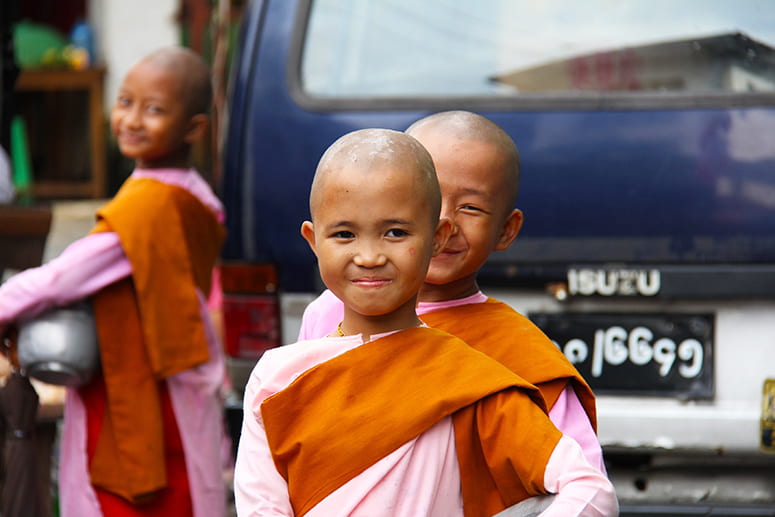
In Review
Buddhist Nuns, Past and Present
A novice of the Jogye order of nuns sweeps the Donghaksa Buddhist Temple in South Korea. Photo by A. Abbas/Magnum Photos
By Martine Batchelor
Many years ago I wrote one of the first books about Buddhist nuns, Walking on Lotus Flowers. I first got the idea to write the book in 1985. At that time, whenever people asked me about my life prior to arriving in England, I generally hesitated. If I said that I had been a nun for ten years in South Korea, there was often a long silence followed by a puzzled acknowledgment that they thought that Buddhist nuns did not exist anymore. It was rather discomfiting to experience such ignorance about the women I had spent ten years of my life with. I knew for myself that Buddhist nuns existed and could be great examples for a life of practice. This is what impelled me to write something about nuns: I wanted to proclaim their existence. For the research of my own book I met many nuns from diverse Buddhist traditions and was deeply inspired by their practice, diligence, sincerity, and creativity. Since then, more books have been written by and about Buddhist nuns; ethnographies, anthologies of poetry, and memoirs have appeared, while the wonderful International Association of Buddhist Women, Sakyadhita, publishes the proceeding of their biannual conference regularly.
Charles Hallisey’s new translation of the Therigatha and journalist Christine Toomey’s In Search of Buddha’s Daughters both add to our knowledge of the history and present lives of nuns. In his introduction, Hallisey presents fascinating historical context about the first Buddhist nuns and their poetry. Moreover, the poems are so well translated that they give us direct access to the emotions and achievements of nuns who lived more than two millennia ago. In Search of Buddha’s Daughters (published in Britain in 2015 as The Saffron Road) shows us in great detail that many different Buddhist nuns still exist and flourish, so much so that I am sure that this book will once and for all put to rest the notion that Buddhist nuns no longer exist and cannot be our modern contemporaries.
The Therigatha as translated by Charles Hallisey is part of the new Murty Classical Library of India and as such is a wonderful new version. The Therigatha is a well-known Buddhist text composed of poems uttered by the first awakened Buddhist nuns 2,500 years ago. There have been different translations and studies over the last 150 years of this seminal text, but this is the first edition that offers a translation accompanied on each page by the corresponding Pali text in romanized script. So, if one knows one’s sukkha (happiness) from one’s dukkha (suffering), one can enjoy recognizing familiar Pali words and seeing what the translator did with each specific term.

Therigatha: Poems of the First Buddhist Women
It was a great pleasure to be asked to review this version of the Therigatha, because for the first time I was able to read it as poetry in one go. Previously, I only dipped into other translations now and then, either because the language felt archaic or because I had difficulty engaging with the commentary on each nun or each poem (though I often returned to the poems of Ambapali, the courtesan, as her sense of irony and humor came through brilliantly). In this version there is a good explanatory introduction at the beginning and some notes at the end on the nuns’ lives, but apart from that we are left with the poems. It is a beautifully produced book. It can stand on its own as a volume of poetries of women speaking to us across the ages.
The Therigatha has significant historical importance as it is considered one of the first collections of poems by women in India and the first anthology of women’s literature in the world. But in his introduction Hallisey emphasizes the text’s poetic beauty and sensibility, pointing out that these poems can stand as art in their own right. The focus in this edition is less on specific nuns and more on their “inspired utterances” as they were transmitted and written down. It is hard to date each poem precisely; scholars have surmised that they were produced over a period of three hundred years from the sixth century BCE to the third century BCE. Their importance is determined by the fact that during this period they were included in the Buddhist canon and thus considered as elevated a discourse as the Buddha’s own. The text is an anthology and as such has evolved over time. The first poems were transmitted orally until they were written down around 80 BCE. Nun Rohini eloquently identifies the authors of these utterances:
Those who have gone forth
are from various families and from various regions
and still they are friendly with each other—
that is the reason why
ascetics are so dear to me. (147)
Charles Hallisey translated the text as is. First there are the earliest poems of a single verse, then two verses, and so on and so forth. Toward the end we find longer and later poems with twenty verses, thirty verses, even forty verses. Individual voices and dramas emerge with great force through these verses. A few tropes that are relatively repetitive give a flavor of the Buddhism of that time. The description of the nuns’ awakening and of their liberation is similar. For instance, many poems in the book echo the nun Sama when she proclaims:
The end of craving has been achieved by me
and what the Buddha taught is done
because of delight in diligence
prompted by the many things that are nothing but suffering. (31)
Apart from such continuities, each voice is quite distinct and personal, as they describe the different circumstances that led them to become nuns. At times, I felt I was reading the script of a modern soap opera. In one poem, a nun named Chapa remembers an episode with her husband:
And, good-looking, what about this child,
born because of you?
Who are you leaving
when you leave me,
the one who has this child? (155)
Or from a nun named Uppavalavanna:
We were mother and daughter,
but we shared one husband,
I was afraid of what had to come from that,
it was perverse and made my hair stand on end. (117)
All the poems have to be seen in the context of the traditional Buddhist belief in rebirth as the bane of existence and enlightenment as the way to escape rebirth. As the nun Mutta says:
The name I am called by means freed
and I am quite free, well free from three crooked things,
mortar, pestle, and husband with his own crooked thing.
I am freed from birth and death,
what leads to rebirth has been rooted out. (11)
There are some short poems about meditation and how to access it. Sumangala’s mother utters:
As I destroyed anger and the passion for sex,
I was reminded of the sound of bamboo being split,
I go to the foot of a tree and think, “Ah, happiness,”
and from within that happiness, I begin to meditate. (21)
My only difficulty with the translation is that sometimes the English version is somewhat intense and strong. In the above verse, you have the Pali term raga, which Hallisey translates as “passion for sex,” but he could have just as easily used the word “desire.” His word choice might make for strong modern poetry, but as a spiritual text it sounds a little extreme and intense at times. For example, again and again Hallisey translates asava and related terms as “depravities,” “oozing out,” and the like. Literally, this word means “influxes,” “leaking out.” In moving from leaking to oozing, there seems to be some parti pris from the translator. But it is true that the translation is very modern and readable. Nowadays, where sex is alluring and supposed to sell everything, it can be quite refreshing (or shocking, depending on your point of view) to see the ancient vision of these nuns. Here the nun Therika recounts the Buddha’s advice to her in her own poetic voice
So sleep well, covered with cloth you have made,
your passion for sex shriveled away
like a herb dried up in a pot. (3)
As Hallisey points out in the introduction, there is some correspondence between these Buddhist verses and nonreligious Indian lyrical poetry of the period, where you will find certain tropes about nature and the beloved. In the Buddhist context of the Therigatha, these tropes are transformed to serve a spiritual purpose. So you start with beautiful, romantic description and then you will have the catch, the Buddhist turning point. The best one comes toward the end of the book, with a series of poems of thirty verses telling the story of a rake lusting after a beautiful young nun. He tries to entice her with flowery language, praising all aspects of her body. He even tells her that he cannot live without her beautiful eyes, which he compares to blue lotus buds or the eyes of a fawn. The nun Subha’s reply is a striking treatise on Buddhist conditionality:
My body parts are like that,
they don’t exist without smaller bits,
and the body itself doesn’t exist without those parts—
what would you fix your mind on there? . . . (193)Eyes are just little balls in various shapes.
With its tears, an eye is a bubble of water between the eyelids
like a little ball of lac in the hollow of a tree,
and milky mucus comes out of it. (195)
Most of the poems are by the nuns, but sometimes a few lines are added, often at the beginning or the end, by the compilers of the scriptures to add context to the occasion. The people who compiled this text finish Subha’s poem by telling us that the nun gouged out one eye to give it to her suitor, but that later on, when she met the Buddha, the eye was miraculously restored.
My favorite poem, by the former courtesan Ambapali, features a similar twist. Each of the poem’s twenty verses starts with two lines of lyrical poetry describing her beauty, and then there is the turning point, which here is about the teaching of impermanence. There is economy and humorous irony in her poetry:
When I was young, my nose was beautiful,
it was delicate, high, and was perfect for my face,
now because of old age
it is like a strip of wet leather. . . (133)Once my feet were beautiful,
so soft they seemed filled with cotton,
now because of old age
they are wrinkled, with calluses cracked. (139)
In these poems we get a glimpse of these women, their former lives, their suffering, their happiness, what they left behind, and the peace they have found in their new lives as nuns. They come from different backgrounds, rich and poor, widowed or married. There are young girls on the threshold of an expected role that they reject, as they are looking for something more. Some find themselves questioning their established beliefs. During this period the Buddha was trying to teach new meditative practices and a different orientation to life, which led these women to reflect pragmatically on what they were doing. These reflections and practices made them leave behind the rituals and traditions that had defined their lives. This subject is broached several times in the poems. For example, in one poem a nun named Punna questions the ritualistic washing of a brahman:
Who told you that,
like a know-nothing speaking to a know-nothing,
that one is freed from the fruits of an evil act
by washing off in water?Is it that frogs and turtles
will all go to heaven,
and so will water monitors and crocodiles,
and anything that lives in water, . . . (125)If you fear suffering, if you dislike suffering,
don’t do action that is evil, whether openly or in secret. (127)
Or the nun Mitta, who once dreamt of obtaining a god’s body through religious rites but, after becoming a nun, realized that this was not the point:
Today I eat just one meal a day,
my head is shaved,
and wear the outer robe of a nun.
My heart’s fear and its sorrow are gone:
I don’t want a god’s body either. (27)
These ancient nuns can teach us how to face the challenges that we encounter while questioning certain cherished assumptions. The nuns of the Therigatha speak to our own era and have the power to inspire contemporary nuns, lay practitioners, and spiritual seekers alike.
With the Therigatha we traveled in time, while with In Search of Buddha’s Daughters we travel geographically and across cultures. What is striking about the book is that it is written by an investigative journalist. For twenty years Christine Toomey reported on foreign affairs for The Sunday Times and twice won Amnesty International’s prize for Magazine Story of the Year. As Toomey explains in her introduction:
After so much time spent shedding light on some of the darkest corners of humanity, the consequences of such tragedies have become frighteningly familiar. Yet over the years I have been deeply moved by the courage many of the women I interviewed had discovered in themselves, my belief being that, ultimately, it could inspire us all. So when, in the course of writing about the Dalai Lama’s political successor, I begin to encounter the stories of Buddhist nuns, I am touched by their strength and conviction, and heartened too. Because the courage these women show is born not only of tragedy and brutality, but also of something more uplifting: a longing to achieve their own enlightenment, and a compassion and determination to help others to achieve it too. (9)
Toomey’s approach is not religious but investigative. She is interested in people, why they make the choices they do and how they subsequently live their lives. Thus, she goes out and finds many nuns with fascinating life stories, detailing their evolution from the start of their spiritual journeys to where they find themselves now. Toomey meets nuns in their traditional settings in Nepal, India, Burma, and Japan and opens our eyes to their lives and aspirations. To make the picture more complete, she also travels to North America, Great Britain, and France, where establishing a nunnery is still a difficult undertaking requiring determination, dedication, and support. In Asian countries, where Buddhism is the main or one of the main religious traditions, monastics are well supported. In the Americas or Europe, where there is generally little societal or cultural support, Buddhist monastics are on their own and have to find supporters or support themselves by working.

In Search of Buddha’s Daughters
One case in point is Aryana Bodhi, a newly established hermitage on the Sonoma Coast in California that is trying to reestablish full ordination for nuns (bhikkhunis) in the Theravada tradition. Their community is a small and extremely rustic beginning—as Toomey points out, they “rely on solar camping showers and rudimentary cooking facilities”—but in May 2012 they were able to have their first ordination ceremony for two women candidates (215).
The book contains many vignettes of the lives of nuns that are at once extraordinary and humanizing, like when the author asks a young Tibetan refugee in a nunnery near Dharamsala, India (where the Dalai Lama lives), how she feels about being a nun: “Her features light up. ‘It makes me feel as if I’m standing on a tall mountain,’ she says. ‘It makes me feel as if I can see a long way’ ” (5). I was not aware that there were nuns practicing kung fu in Nepal or that a nun in Myanmar was imprisoned for “impersonating a monk” (!) or that there exists a Japanese Zen nun celebrated for her erotic fiction. Toomey also meets a princess, a former antiterrorist policewoman, a former Bollywood star, a former presenter of the BBC program Top Gear, Switzerland’s first female commercial pilot, a former political aide, a former Paris catwalk model, a former banker, and so on. The book details an incredible array of nuns’ experiences, motivations, and lifestyles. At the same time, we become acquainted with the different cultures of several Buddhist monastic traditions. Toomey’s dedication to covering her subject thoroughly is a great gift to the reader: without having to go anywhere, we are able to intimately encounter a wide breadth of lives and traditions.
Toomey also deals with some of the more emotionally and politically fraught aspects of her subject, profiling a nun named Dhamchoe who suffered greatly as a political prisoner in the notorious Drapchi prison in Lhasa for many years. After being released, she escaped from Tibet to Dharamsala in India, where she now works in a teashop. Dhamchoe does not feel that she can continue to be a nun officially but still tries to be a nun in spirit. As she points out: “As far as I’m concerned, I’m still a nun, I live the life of a nun in every way I can. . . . His Holiness [the Dalai Lama] tells us that it’s not the clothes you wear that make you a monk or a nun. It’s the way you live, having a pure mind” (81).
In Search of Buddha’s Daughters also recounts Toomey’s own spiritual journey in facing her own personal suffering, namely, the recent death of her parents. She is uplifted by her encounters with these Buddhist women who moved from a so-called conventional life to an unconventional life, that of nuns dedicating their lives to awakening for the sake of all. Soon she realizes:
[T]he journey I was about to undertake would comprise three interwoven journeys: one following the paths that Buddhism has travelled from East to West, the second tracing the extraordinary individual paths taken by women to becoming Buddhist nuns, and the third pursuing my own search for deeper understanding and a wisdom that would heal. (11)
One might have the impression that women become Buddhist nuns because of failure or a romance gone wrong. But for the nuns here, this is obviously not the case. Of course, some nuns are escaping a difficult life, like a young Tibetan nun whose father was an alcoholic who brutalized his family. In the nunnery she finds peace, stability, and safe relationships but also understanding and compassion as she starts to see why her father became that way. She does not condone his actions but develops compassion for the misguided human being. Most of the women Toomey interviews, and is inspired by, do not become nuns to avoid something but to find a supportive community and a transformative practice.

Young Thilashin in Myanmar out on alms rounds. Pixabay
What strikes Toomey more than these nuns’ peacefulness is their joy, despite seemingly being denied what is generally considered to give people happiness. What also comes across is their energy. They are not just sitting there, floating on clouds of equanimity. On the contrary, they are actively involved in the communities they serve and depend upon.
Like the nuns of the Therigatha, the women in In Search of Buddha’s Daughters touch us in many ways: by their actual lives and their aspiration, their practice and the fruits of their practice. Each nun’s life is a possibility in itself, that a life can be lived in that way. This is one of the suggestions of Tenzin Palmo, the longest ordained European woman to become a Buddhist nun and the most famous of the nuns interviewed here. In her conversation with Toomey, she clearly and eloquently states that the existence of a different way of life is important in and of itself:
This life is not for everyone. . . . But knowing that there are groups of monastics who are happy being monastics gives people a sense of proportion. . . . I think it’s very important to have a group of people who are living a life based on contentment with little, who live the example that genuine joy comes from within, from a sense of leading a life well lived. (110)
Reading the Therigatha and In Search of Buddha’s Daughters, I was in turn challenged, inspired, and moved. These two books are a great contribution to our knowledge about ancient and modern Buddhist nuns, but, more than that, the lives and words of these nuns can help each of us explore what it means to be human and to develop our humanity to the fullest.
Martine Batchelor was a Zen nun in Korea for ten years. She is the author of Meditation for Life, The Path of Compassion, Women in Korean Zen, Let Go, and The Spirit of the Buddha. She teaches meditation retreats worldwide and lives in France.
Please follow our Commentary Guidelines when engaging in discussion on this site.


I have been reading Poems of the First Buddhist Women as part of our Masters programme Masters in Buddhist Classics at Dharma Realm Buddhist University, Ukiah CA
I am from New Zealand and would like to receive your Bulletin to see what Harvard has to offer and as a source of research material
Peace
Sheryl